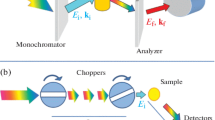Summary
Neutron reflectometry is an excellent technique to determine the structure of a protein layer adsorbed at a solid interface. The use of contrast-variation makes it possible to highlight the adsorbed protein layer. The neutron scattering lengths of D and H have opposite signs. By choosing the H2O/D2O ratio, the scattering length density can be made equal to that of the adsorbing substrate. To determine the scattering length density of protein, both its volume and its scattering length in solution is needed. To calculate the scattering length, the H-D exchange of the labile protons of the protein should be taken into account. For monitoring the H-D exchange, electrospray ionization mass spectroscopy (ES+I-MS) was applied. We show that ES+I-MS is the appropriate technique for quantitative analysis of the H-D exchange. We compare the experimental results for the exchange in lysozyme and &bgr;-casein with theoretical calculations.
Similar content being viewed by others
Author information
Authors and Affiliations
Rights and permissions
About this article
Cite this article
Bouwman, W. Neutron and ion beams in biological research. J Radioanal Nucl Chem 264, 271–275 (2005). https://doi.org/10.1007/s10967-005-0706-9
Published:
Issue Date:
DOI: https://doi.org/10.1007/s10967-005-0706-9




